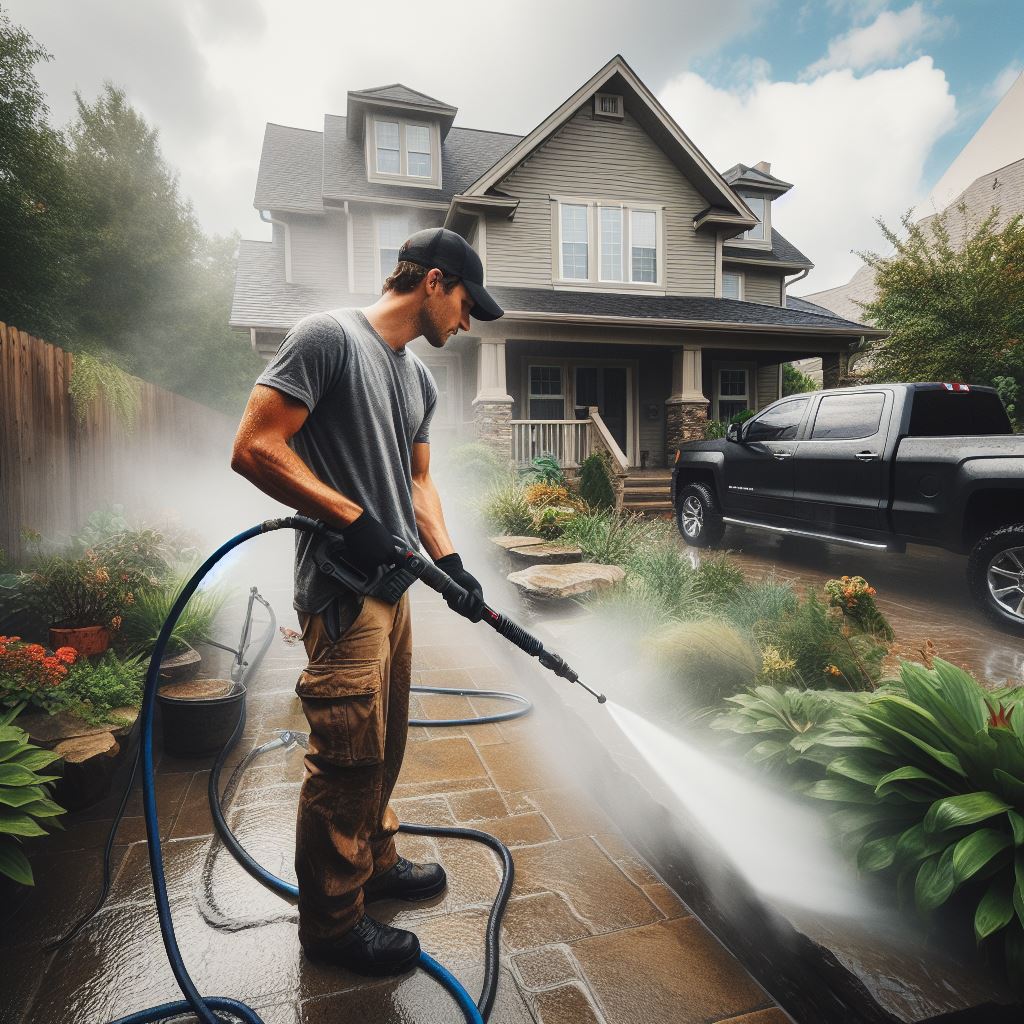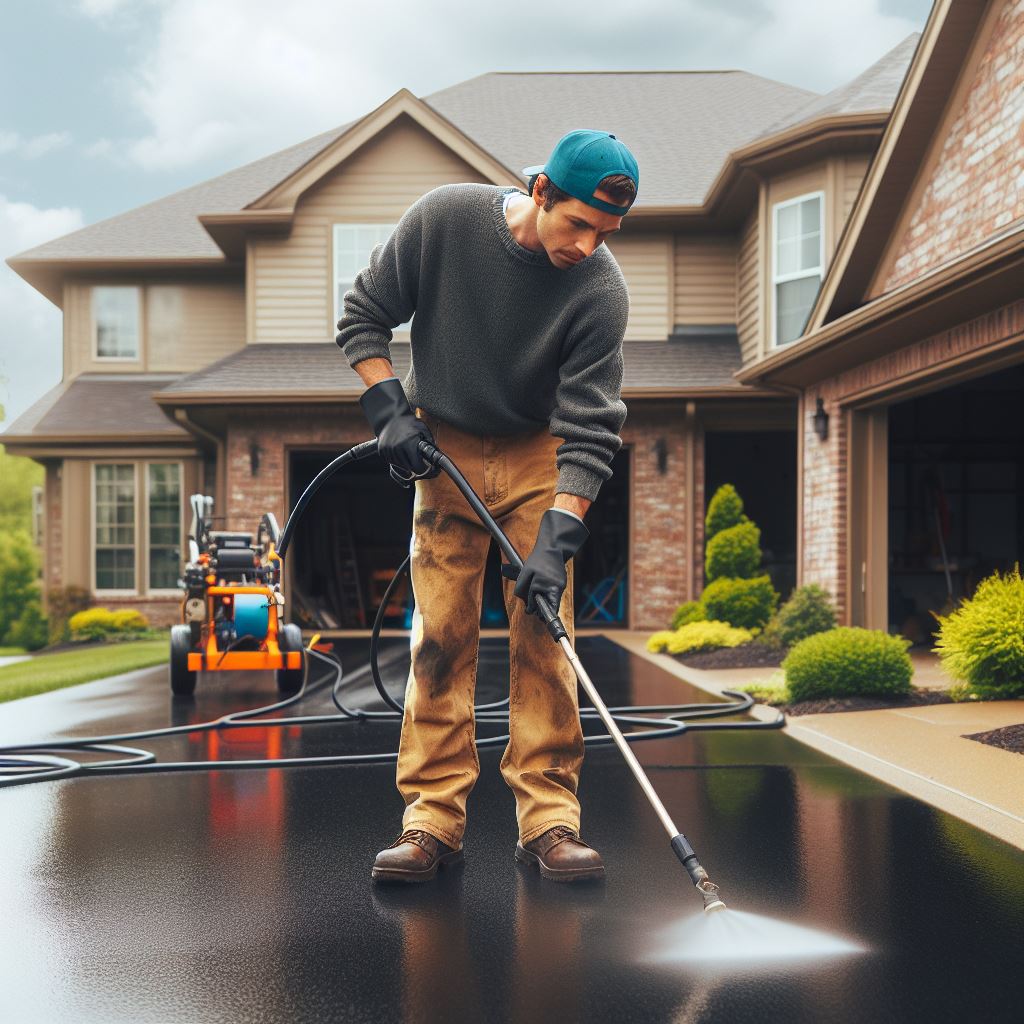
When you use a pressure washer, remember it’s like wielding a powerful cleaning wand that can transform surfaces back to their brand-new glory. The key here is to pick the correct settings—it’s the secret sauce for effective and safe cleaning. So, think about what type of surface you’re cleaning, how dirty it is, and the water pressure and flow rate.
We’ll walk you through the best pressure washing settings for various surfaces, such as concrete, wood, and brick and give you some handy tips on using the right settings to avoid damage and keep things safe.

What is Pressure Washing?
If you want a top-notch cleaning method, pressure washing is the way to go. It works wonders by blasting away dirt, grime, debris, and stains with high—or low-pressure water spray.
You can use this versatile cleaning trick on all surfaces, from concrete driveways and wooden decks to vinyl siding, brick walls, and even vehicles. Pressure washing doesn’t just tackle tough stains and dirt—it also helps keep the outside of your home or business looking spick and span. Just adjust the water pressure and use the proper cleaning techniques to get fantastic results without risking any damage to the surface you’re cleaning.
Factors to Consider When Choosing Pressure Washing Settings
When you’re picking out your pressure washing settings, consider a few things to ensure the best cleaning results and the safety of your surfaces.
Type of Surface
When pressure washing, you need to consider the type of surface you’re dealing with. Think about the surface conditions, any existing damage, and whether your cleaning methods are suitable.
Different surfaces, like concrete, wood, and vinyl, have unique quirks that require specific pressure washing techniques. For example, concrete can handle more pressure than delicate wood surfaces.
Before you start pressure washing, take a good look at the surface conditions. This can help you avoid potential damage. Be extra careful with high-pressure settings on fragile surfaces to prevent unnecessary harm. Always ensure the cleaning techniques you’re using match the surface you’re working on to get the best and safest cleaning results.
Level of Dirt and Stains
Regarding pressure washing, consider the surface level of dirt and stains to determine the correct settings for blasting away contaminants like grime, debris, mold, mildew, and algae.
Adjusting the water pressure is crucial depending on how tough the dirt and stains are. Crank it up for stubborn grime, but dial it down for more delicate surfaces.
Remember to use the right cleaning solutions to level up your cleaning game. A mild detergent works great for general cleaning, but bring out the big guns, like specialized solutions, for those stubborn oil or grease stains.
Don’t overlook the techniques—start from the top and work your way down to avoid streaks, and make sure to use overlapping strokes for a thorough and even clean.
Water Pressure and Flow Rate
When you’re pressure washing, getting the water pressure and flow rate right is vital to cleaning those squeaky surfaces. Whether cranking up the pressure or keeping it low-key, using the correct nozzle tips, sizes, and pressure levels is crucial for top-notch results.
Adjusting the water pressure and flow rate to match what you’re cleaning is a game-changer in the effectiveness of your pressure washing. Different surfaces and cleaning tasks call for different pressure and flow levels. Using the wrong settings could mean you’re not effectively getting rid of dirt or, even worse, damaging the surface.
So, when choosing your nozzle tips, sizes, and pressure levels, consider the surface you’re dealing with. Whether it’s delicate wood, tough concrete, or something stubbornly stained, choosing the right combo of settings will not only make your cleaning job easier but keep your equipment and surfaces in tip-top shape for longer.
Common Pressure Washing Settings for Different Surfaces
When pressure washing, you must adjust the settings based on the cleaning surface. For concrete and driveways, crank up the pressure for the best results. Wooden decks and fences do well with moderate pressure. When it comes to delicate surfaces like brick and stone, dial it back to a lower pressure setting.
Concrete and Driveways
When pressure washing concrete surfaces and driveways, you need to crank up the pressure settings to eliminate all that dirt, grime, and stains. This is key to keeping your exteriors spick and span and making sure they last longer.
This approach gets down and dirty, diving into the nooks and crannies of the concrete to lift out all the embedded debris. Start gently with a low-pressure setting, then work your way up to avoid mishaps. A wide-angle nozzle can help spread the pressure evenly so there are no streaks or marks.
Regular pressure washing isn’t just about giving your property a facelift—it also prevents mold, mildew, and other nasties from taking hold. So, not only will your place look great, but it’ll be a healthier environment, too.
Wooden Decks and Fences
When pressure washing your wooden decks and fences, remember to take a gentler approach by adjusting the pressure settings to prevent any damage while still getting those surfaces looking good as new.
Use the proper pressure washing settings for your wooden decks and fences to keep them looking their best for the long haul. Keep in mind the delicate nature of wood when choosing your pressure level. Stick to lower pressure settings and wide spray nozzles to avoid splintering or harm to the wood. Pick a cleaning solution made specifically for wood surfaces to remove dirt, mold, and grime without hurting the wood fibers. Remember to keep the nozzle safe from the wood and move it consistently in a sweeping motion to ensure you clean thoroughly.
Brick and Stone Surfaces
When pressure washing brick and stone surfaces, you need to focus on prepping the surface and using lower pressure to clean it without damaging it.
Before you start the pressure washing, make sure to give the surfaces a once-over with a brush or broom to remove loose debris, dirt, or grime. This step is important to avoid clogging the pressure washer and ensure a thorough cleaning.
You might also want to consider using a cleaning solution specifically made for brick and stone surfaces to remove tough stains.
Regarding the pressure settings, choose a lower level to be safe and avoid any potential damage to the surfaces. And don’t forget about your plants and grass nearby—give them a good soak with water and cover them with a tarp before you start pressure washing to keep them safe.
Tips for Using the Right Pressure Washing Settings
If you want to get those surfaces clean and sparkling with pressure washing, you need to pay attention to some important tips and recommendations. Make sure you use the right equipment, follow safety precautions, and adjust the settings based on the surface you’re cleaning.
Avoiding Damage to Surfaces
To prevent surfaces from being damaged during pressure washing, you need to pay close attention to the right settings, the sensitivity of the surface, and the proper techniques to avoid any unintended mishaps while still getting the job done effectively.
Set the pressure washer to the correct level based on your cleaning surface. If you’re working on delicate surfaces like wood or painted areas, opt for lower-pressure settings to avoid any potential harm. Adjusting the nozzle spray pattern can also help you control the water stream’s intensity, ensuring a more gentle cleaning process. Following these tips and techniques, you can clean surfaces effectively without causing unwanted damage or side effects.
Protecting Yourself and Others
To keep yourself and others safe while pressure washing, follow some key safety tips, maintain a regular cleaning schedule, and keep on top of maintenance to meet cleanliness and safety standards.
Put on the right gear – gloves, goggles, and sturdy shoes – to shield yourself from potential injuries due to debris or chemical splashes. It’s all about staying safe while getting the job done.
Knowing how to handle your pressure washing equipment properly is crucial. Understanding the proper nozzle settings and water pressure levels can prevent accidents and help you get the best cleaning results possible.
Stick to a consistent cleaning routine to keep things looking good and prevent the build-up of dirt and grime that could become safety hazards over time.
When you follow these safety steps and keep up with maintenance tasks, you create a safe environment for yourself and anyone else around you. It’s a win-win for everyone involved.